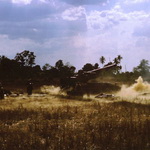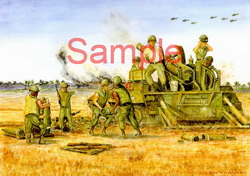|
Memories of the Voyage to Vietnam
By
John W. Anderson
Battery 6th Battalion 27th Artillery
Radio Teletype Specialist 4 Class
In 1964 I
entered the US Army and eventually was assigned to an artillery
battalion as a radio-teletype operator. Fort Bliss Texas near El
Paso was home of the 8th Artillery and its eight inch
“towed” artillery battalion. Soon after the old tow behind a truck
guns were replaced with self propelled guns. When the war in Vietnam
heated up and President Johnson began sending combat troops all of
the guys in the 8th were transferred to the 27th
Artillery if they had 6 months of time left in the Army. I had 7
months left to serve on my two year hitch at the time The 27th
Artillery was outfitted with new self-propelled 8 inch howitzers and
a collection of old equipment to make it fully functional. The
outfit was located in Logan Heights at Fort Bliss.
We were never
told we were being sent to Vietnam. In fact we were not told after
we left San Francisco even though there was nobody to leak
information to but our buddies. We were “officially” told we were
going to land in Vietnam when we reached the mouth of the Saigon
River and began off-loading troops.
In October
1965 we went through a complete departure exercise a month before we
left for Vietnam. After putting everything away after the exercise
we were told to pack up again and this time we got on a train and
headed for San Francisco. I remember sitting in a box car guarding
the company safe as we went across the Mohave Desert to San
Francisco Bay. We actually had little state-rooms with fold down
beds when off-duty just like real people. We boarded the troop ship
USS General Gordon as part of 5000 army troops head for Vietnam. We
were among some of the first contingents sent and no protesters or
anyone else took any notice of us.
The voyage
was unbelievably boring and extremely long. Our outfit was on the
ship for 30 days. Our voyage was blessed with crowed quarters, poor
food, and lack of water for washing clothes and greasy decks that
kept us pretty grubby. The military sea transport food was so poor
that when my battery was put on KP we stole everything that looked
like it could be eaten. During our first day in the galley I saw
lines of men tossing hams out of the cooler along with canned fruit,
loaves of fresh bread and bricks of butter. It all went back to the
squad bays to share. After two days they removed our battery from KP,
put a guard on the galley, and assigned a new outfit to KP. We were
5 decks down and our bunks were 5 tiers high. There was just enough
space between bunks to slide in with our duffle bags, helmets and
rifles. Once the guy above got in his bunk it was nearly impossible
to roll over. The bunks were made of steel pipe frames with canvas
laced to them.
We finally
stopped in Okinawa after 18 days at sea where we had a party at
White Beach. Some party it turned out to be. We couldn’t leave the
ship unless we “donated” a dollar to cover the party supplies. An
Okinawan girl’s band played on a stage for the GI’s while they milled
around, ate hot dogs, and drank beer or soda. Beer was in unlimited
supply and by evening order had disintegrated into many drunks
staggering around or trying to get back to the ship that was about a
mile away. The racial violence began with a number of people being
stabbed after black and white soldiers with too much to drink got
into fights. A number of individuals were left in the hospital I was
told when we sailed. Three individuals were thrown in the ships
brig. One of these individuals set fire to the mattresses in the
brig and before they could be rescued the one who set the fire and
one other died of smoke inhalation. I know this was true because I
was the one who typed up the death notices at the direction of my 1st
Sergeant. I was one of the few sober people available in my unit to
handle the job.
Eating was
and experience. We stood at elevated tables and ate as fast as
possible so more guys could be fed. Feeding 5000 guys took forever.
It seemed like we would no more than leave the mess hall than we
would be standing in chow line again for the next meal. One of my
more memorable experiences was a rough sea when our trays of food
were sliding back and forth on the table as we tried to eat. A big
ship's roll occurred and all the trays slid by and I found myself
looking at someone’s dinner topped with puke. A moment latter the
next roll sent it back down the table to its owner and I got mine
back.
We first
stopped in Qui Nhon harbor such as it was. There were no docks and
we dropped anchor about a mile off-shore. A huge landing craft came
alongside and we off-loaded about a 1000 or more troops. The bay was
crammed with WWII vintage Liberty ships that were trying to land
military supplies. The lack of docks appeared to be a big problem.
We then moved down the coast to Cam Ran Bay where we landed more
troops. It was a beautiful harbor. Being from Coos Bay, Oregon I had
a pretty good appreciation for ports. The old French villas along
the bay were impressive. The ridges around the harbor went up at a
steep angle several thousand feet and were covered by dark green
vegetation. That night the Army was firing parachute flares around
the bay all night long and it reminded me of the scenes from
“Apocalypse Now”. It was eerie and surreal.
Our last stop
was the mouth of the Saigon River near Vung Tau. At this point they
told our outfit we were landing in Vietnam so guys who were hoping
for Thailand had to face reality. I was given 5 rounds for my M-14
rifle to protect the company safe as we went ashore in a landing
craft. No one was given any ammunition and I wondered who or what I
was protecting the safe from. As we neared the beach a flight of A-6
Sky Raiders pealed off and began bombing the jungle behind the
shoreline. At that point I had a surreal feeling like I was part of
an old WWII John Wayne movie. As it turned out there was an airfield
between us and the bombing area.
We sat on the
beach until everyone got landed and then they herded us up to
waiting C-130’s. As is normal we waited and waited to load behind
the planes while they blew furnace hot blasts of exhaust over us.
The air temperature alone was probably over 100 degrees F. Then some
bright officer passed down the order for us to roll up our sleeves
so we could become “acclimatized.” The white guys like me had been
inside a ship for 30 days and were pale as sheets. After several
hours of exposure we finally loaded and took off. The pilot did a
quick maneuver skyward and announced we were being shot-at but
nothing happened. The next day all of us light complexioned guys had
huge sunburns with hanging sacks of lymph on our arms. We could
barely work for the pain and it took 3 weeks to get over the burns.
Very little was available in the way of medication as there was no
field hospital and our medics had only a little cream lotion. We
were finally in Vietnam sitting in young rubber tree plantation near
Bien Hoa Air Base by some place called the Widows Village.
In my mind
the sea voyage was worse than being in Vietnam and I was greatly
relieved when I found out we would fly home at the end of our tour
of duty. It took my wife 30 years to convince me that going on a
cruise would be fun. We have been on five cruises so I did get over
my phobia.
John Anderson
Then and
Now
A Btry 6/27th Artillery
Nov 65 to May 66 |

